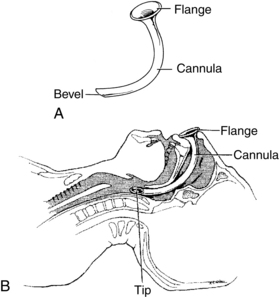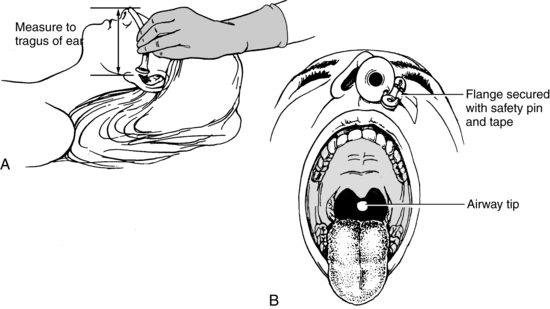PROCEDURE 10 Nasopharyngeal airways are used to maintain a patent airway to the hypopharynx and to facilitate the removal of tracheobronchial secretions by directing the catheter and by averting tissue trauma that is associated with repeated suction attempts.4 • Nasopharyngeal airways are passed through the nose and follow the posterior nasal and oropharyngeal walls to the base of the tongue (Fig. 10-1).3 FIGURE 10-1 Nasopharyngeal airway. A, Airway parts. B, Proper placement. (From Eubanks DH, Bone RC: Comprehensive respiratory care: a learning system, St Louis, 1990, Mosby, 518.) • The nasopharyngeal airway has three parts: the flange, cannula, and bevel or tip. The flange is the wide trumpet-like end that prevents further slippage into the airway. The hollow shaft of the cannula permits airflow into the hypopharynx. The bevel or tip is the opening at the distal end of the tube. When properly inserted, and the correct size, the tip can be seen resting posterior to the base of the tongue. • The external diameter of the nasopharyngeal airway should be slightly smaller than the patient’s external nares opening. The length of the nasopharyngeal airway is determined by measuring the distance between the naris and the tragus of the ear (Fig. 10-2).2 Improperly sized nasopharyngeal airways may result in increased airway resistance, limited airflow (if the airway is too small), kinking and mucosal trauma, gagging, vomiting, and gastric distention (if the airway is too large). Some manufacturers provide nasopharyngeal airways shaped specifically for the right and left nares. FIGURE 10-2 A, Estimating nasopharyngeal airway size. B, Nasopharyngeal position after insertion. (From Eubanks DH, Bone RC: Comprehensive respiratory care: a learning system, St Louis, 1990, Mosby, 552.) • The advantages of the nasopharyngeal airway include increased comfort and tolerance in a conscious patient, stable airway positioning for long periods, decreased incidence of gag reflex stimulation, and minimal incidence of mucosal trauma during frequent suctioning. • Nasopharyngeal airways are especially useful for relieving airway obstruction associated with mandibular-type injuries that result in jaw immobility or soft tissue obstruction. Examples of these injuries include jaw wiring, trismus, pain, edema, jaw spasms, and mechanical impairment such as temporomandibular joint fractures and zygomatic fractures. In selected patient situations, a nasopharyngeal airway may be used to facilitate the passage of a fiberoptic bronchoscope and to tamponade small bleeding blood vessels in the nasal mucosa. • Insertion of the nasopharyngeal airway in an alert patient may stimulate the gag reflex and cause retching and vomiting.
Nasopharyngeal Airway Insertion
PREREQUISITE NURSING KNOWLEDGE


![]()
Stay updated, free articles. Join our Telegram channel

Full access? Get Clinical Tree


10: Nasopharyngeal Airway Insertion
